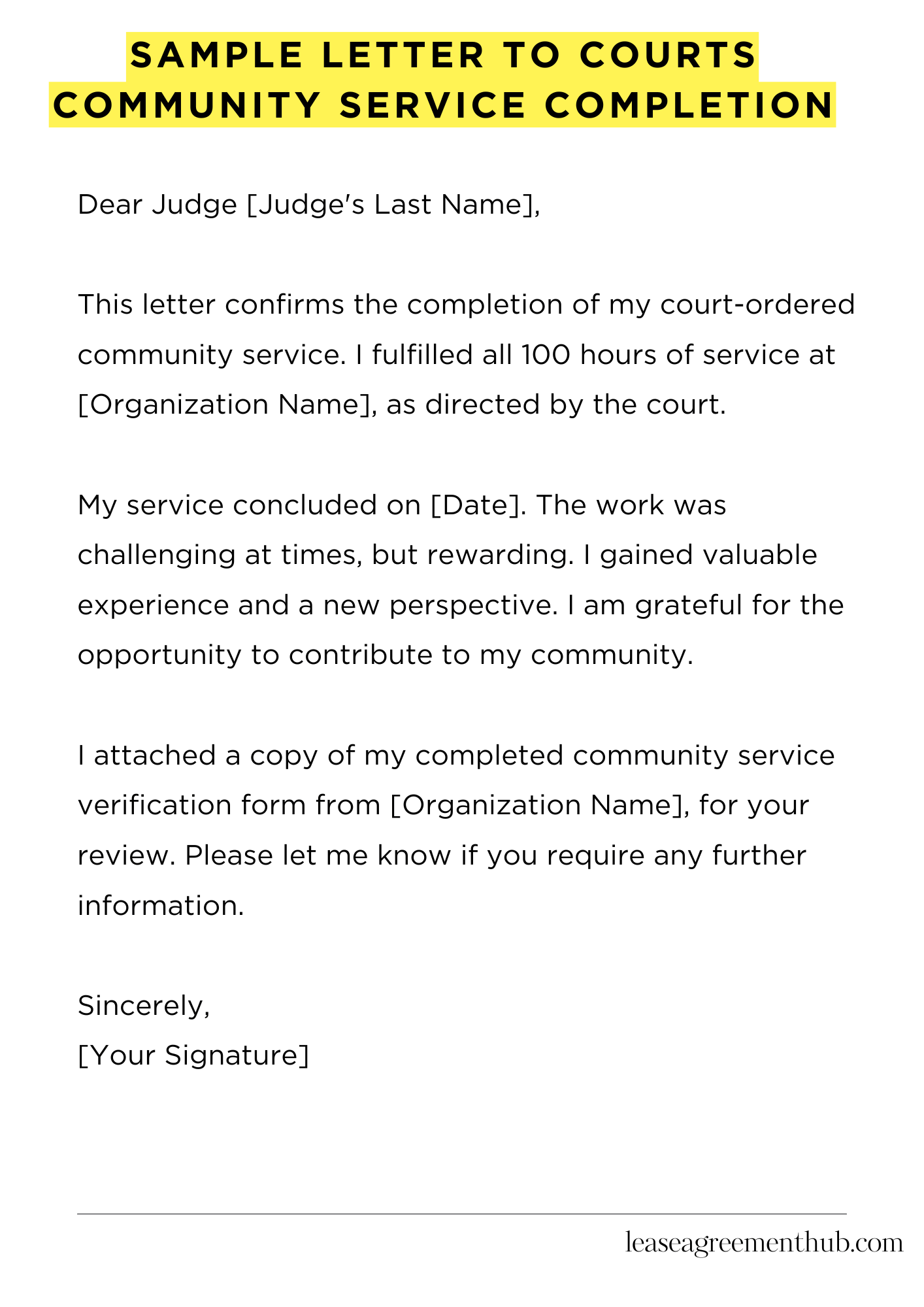This blog post is about letters proving you finished community service. It’s for people who need to show the court they completed their sentence. This is important to avoid further legal issues.
We’ll give you examples of these letters. These are templates. You can use them to write your own letter. They’ll make writing your letter much easier.
These samples cover different situations. They’ll help you write a clear and effective letter. Use them as a guide. Then personalize it to your situation.
sample letter to courts community service completion
[Your Name]
[Your Address]
[Your Phone Number]
[Your Email Address]
[Date]
The Honorable Judge [Judge’s Last Name]
[Court Name]
[Court Address]
Dear Judge [Judge’s Last Name],
This letter confirms the completion of my court-ordered community service. I fulfilled all 100 hours of service at [Organization Name], as directed by the court. My service concluded on [Date]. The work was challenging at times, but rewarding. I gained valuable experience and a new perspective. I am grateful for the opportunity to contribute to my community.
I attached a copy of my completed community service verification form from [Organization Name], for your review. Please let me know if you require any further information.
Sincerely,
[Your Signature]

How to Write a Sample Letter to Courts: Community Service Completion
Understanding the Purpose: A Necessary Articulation
The primary objective of this letter is unequivocally straightforward: to formally notify the court of your diligent completion of mandated community service. It’s not merely a formality; it’s a crucial element in fulfilling your legal obligations. This letter serves as irrefutable proof of your compliance and should be approached with meticulous care.
Structuring Your Epistolary Communication: A Comprehensive Guide
Begin with a precise and formal salutation, addressing the judge or relevant court official by their proper title. Clarity is paramount. Then, succinctly state your purpose: the notification of completed community service. Include your case number for facile identification. Next, provide specific details regarding the service performed, including the organization’s name, the total hours served, and the dates of service. Concisely detail your role and contributions. A conclusion reiterating your completion and expressing gratitude for the opportunity is vital before a formal closing.
Essential Information: Ensuring Veracity and Accuracy
Accuracy is paramount. Omitting or obfuscating information is inadvisable. Include the complete name and contact information of the supervising organization. Provide a verification method, such as a signed certificate or statement from a designated supervisor. This corroborative evidence bolsters the credibility of your claim. Remember, inaccuracies can lead to detrimental consequences. Accuracy is your shield against potential repercussions.
Crafting Persuasive Language: The Art of Measured Eloquence
While formality is key, your letter needn’t be devoid of personality. Maintain a respectful and professional tone. Avoid any semblance of defensiveness or contentiousness. Use clear, concise language, avoiding jargon or overly verbose phrasing. Remember, your goal is to convey your compliance in a straightforward and unambiguous manner. Elegance in simplicity can be profoundly effective.
The Importance of Proof and Verification: Leaving No Room for Ambiguity
Attach copies of all relevant documentation. This includes the certificate of completion from the community service organization, any correspondence from the court, and any other pertinent paperwork. This irrefutable evidence underscores the veracity of your claim and minimizes the potential for misunderstandings or delays. Consider this an exercise in meticulous record-keeping. Thoroughness is not merely recommended; it is essential.
Submitting Your Correspondence: Navigating the Procedural Labyrinth
Follow the court’s specified submission guidelines diligently. Whether it’s via mail, email, or in person, adhering to the prescribed method is non-negotiable. Proof of submission, such as a tracking number or confirmation email, should be retained. This provides a record of your compliance and protects you from potential administrative hiccups. Diligence in this aspect is crucial for a seamless resolution.
Review and Revision: A Final Polishing Before Submission
Before submitting your letter, meticulously review it for any errors in grammar, spelling, or formatting. A polished letter speaks volumes about your attentiveness and regard for the judicial process. Ask a friend or family member to proofread it for a fresh perspective. A final, critical review will ensure that your communication is impeccable. This final check is your last opportunity to perfect your submission.
FAQs about sample letter to courts community service completion
What information should be included in a letter confirming community service completion?
A letter confirming community service completion should include the individual’s full name, case number (if applicable), the name and address of the organization where the service was performed, the dates of service, the total number of hours completed, and a statement confirming the satisfactory completion of the required service. It should also include the signature and contact information of the supervising official at the organization.
Who should write the letter confirming community service completion?
The letter should be written by a responsible official at the organization where the community service was performed. This is typically a supervisor or program coordinator who can verify the individual’s participation and hours completed.
What format should the letter follow?
The letter should follow a formal business letter format. This includes using a professional tone, clear and concise language, and proper grammar and punctuation. It should be typed on official letterhead if possible, and include the date, recipient’s address, and a closing salutation.
Where should the letter be sent?
The letter should be sent to the court or probation officer responsible for overseeing the community service requirement. The specific address will be provided by the court or probation officer.
What if there were issues or challenges during community service completion?
If there were any issues or challenges during the completion of community service, these should be addressed honestly and transparently in the letter. However, the focus should remain on the successful completion of the required hours. It is best to contact the court or probation officer directly to discuss any significant problems.
Related: